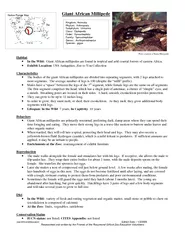/


Giant African Millipede Photo courtesy of Karen Marzynski Habitat In the Wild Giant African millipedes are found in tropical and arid coastal forests of easte ID: 122497
Download Pdf The PPT/PDF document "GiantAfricanMillipedekm Edition Date " is the property of its rightful owner. Permission is granted to download and print the materials on this web site for personal, non-commercial use only, and to display it on your personal computer provided you do not modify the materials and that you retain all copyright notices contained in the materials. By downloading content from our website, you accept the terms of this agreement.
GiantAfricanMillipedekm Edition Date 1/3/2006 Researched and written by the Friends of the Rosamond Gifford Zoo Education Volunteers Giant African Millipede Photo courtesy of Karen Marzynski Habitat In the Wild: Giant African millipedes are found in tropical and arid coastal forests of eastern Africa. Exhibit Location: USS Antiquities, Zoo to You CollectionCharacteristics The bodies of the giant African millipedes are divided into repeating segments, with 2 legs attached to most segments. The average number of legs is 100 (despite the milli prefix). Males have a space between the legs of the 7th segment, while female legs are the same on all segments. The first segment comprises the head, which has a single pair of antennae, a cluster of simple eyes, and a mouth. Breathing pores are located on their sides. A hard, smooth, exoskeleton provides protection. They can grow to be up to 12 inches long. In order to grow, they must molt, or shed, their exoskeleton. As they molt, they grow additional body segments with legs. Lifespan: In the Wild 7 years; In Captivity 10 years Behaviors Giant African millipedes are primarily nocturnal, preferring dark, damp areas where they can spend their time foraging and eating. They move their strong legs in a wave-like motion to burrow under leaves and other organic matter. When startled, they will roll into a spiral, protecting their head and legs. They may also secrete a yellowish-brown fluid (hydrogen cyanide), which is a mild irritant to predators. If sufficient amounts are applied, it may be an irritant to people. Enrichments at the Zoo: rearrangement of exhibit furnitureReproduction The male walks alongside the female and stimulates her with his legs. If receptive, she allows the male to slip under her. They wrap their entire bodies for about 2 turns, with the male deposits sperm on the female. She transfers the sperm to her eggs. Later she makes a nest of compressed soil just below ground level. A few weeks after mating, the female lays hundreds of eggs in this nest. The eggs do not become fertilized until after laying, and are covered with a tough, resistant coating to protect them from predators and poor environmental conditions. Sometimes the female will guard the eggs until they hatch (about 3 months later). The young are abandoned after hatching, but grow quickly. Hatchlings have 3 pairs of legs and a few body segments and will take several years to grow to full size. Diet In the Wild: variety of fresh and rotting vegetation and organic matter, small stone or pebble to chew on (exoskeleton is composed of calcium) At the Zoo: fruits, vegetables, cuttlebone Conservation Status IUCN status: not listed; CITES Appendix: not listed Native Range Map Kingdom: Animalia Phylum: Arthropoda Subphylum: Uniramia Class: Diplopoda Order: Spirostreptida Family: Spirostreptidae Genus: Archispirostreptus Species: gigas GiantAfricanMillipedekm Edition Date 1/3/2006 Researched and written by the Friends of the Rosamond Gifford Zoo Education Volunteers Giant African millipedes are a popular pet and are often found as part of wildlife education programs.Captive breeding is easily accomplished. Millipedes and other insects are essential for maintaining the balance in nature and health of the living world. Predators: snakes, birds, mammals Did You Know?/Fun Facts Giant African millipedes have a symbiotic relationship with mites which live on their exoskeleton and near their legs. They provide the mites with a home and food, and the mites keep the millipedes exoskeleton clean by eating debris off of it. These mites are harmless to people. There are over 1000 species of millipedes worldwide. One way to distinguish a millipede from a centipede is by the number of legs and segments. Centipedes have 1 pair of legs per segment and legs emerge from the sides of each segment. Centipedes move in snake-like serpentine patterns and are carnivores (meat-eaters). Millipedes have 2 pairs of legs per segments, for the most part, and their legs emerge from underneath each segment. Millipedes move in a straight, forward manner and are herbivores (plant eaters). The many legs do not give them speed, but rather power for digging through soil and debris. Sources : Happy Hollow Park Zoo, (2005). Meet the animals: giant african black millipede. Retrieved Oct. 22, 2005, from Happy Hollow Park Zoo Web site: http://www.hhpz.org/zoo/theanimals/introducing.php3/GABMill. Woodland Park Zoological Society, (n.d.). Animal fact sheets: giant millipede. Retrieved Aug. 15, 2005, from Woodland Park Zoological Society Web site: http://www.zoo.org/educate/fact_sheets/milli/milli.htm.